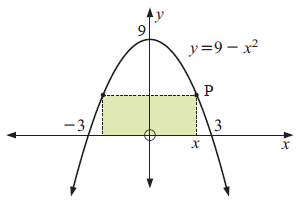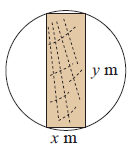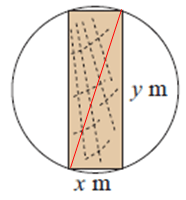CALCULUS OPTIMIZATION PROBLEMS
To find the maximum and minimum turning points of y = f(x), we need to find x such that f'(x) = 0
Step 1 :
Draw a large, clear diagram for the situation.
Step 2 :
Construct the equation with the variable to be maximized or minimized as the subject of the formula in terms of the single variable x.
Step 3 :
Find the first derivative and equate to 0 to get the critical number.
Step 4 :
Apply the value that we have received as critical number in the second derivative.
- If f''(x) > 0 at x = a, then at x = a the function will reach its minimum
- If f''(x) < 0 at x = a, then at x = a the function will reach its maximum.
Step 5 :
To find the maximum or minimum value, we have to apply the value of x in the original function.
Problem 1 :
If a business employs x workers to manufacture furniture then the profit made by the business given by
P(x) = -3x3 + 6084x - 5000 dollars per week
a) How many employees should the business have to maximize the profit ?
b) What is the maximum profit ?
Solution :
P(x) = -3x3 + 6084x - 5000
P'(x) = -3(3x2) + 6084(1) - 0
P'(x) = -9x2 + 6084
P'(x) = 0
-9x2 + 6084 = 0
-9x2 = -6084
x2 = 6084/9
x2 = 676
x = 26
Applying the value of x in the second derivative.
P''(x) = -9(2x) + 0
P''(x) = -18x
Applying x = 26
P''(26) = -18(26) < 0 maximum at x = 26
a) So, the number of employees should have in the business is 26.
b) Maximum profit,
P(26) = -3(26)3 + 6084(26) - 5000
= -3(17576) + 158184 - 5000
= -52728 + 158184 - 5000
= 100456
Problem 2 :
Two numbers have the sum of 10. What is the minimum value that the sum of their cubes could be ?
Solution :
Let x and 10 - x be two numbers,
Let the required function be f(x).
f(x) = x3 + (10 - x)3
f'(x) = 3x2 + 3(10 - x)2 (-1)
f'(x) = 3x2 - 3(10 - x)2
f'(x) = 0
3x2 - 3(10 - x)2 = 0
x2 = (10 - x)2
x = 10 - x
x + x = 10
2x = 10
x = 5
Applying the value of x in the second derivative.
f''(x) = 6x + 6(10 - x)
= 6(5) + 6(10 - 5) > 0
Minimum at x = 5.
Minimum value = x3 + (10 - x)3
= 53 + (10 - 5)3
= 125 + 125
= 250
Problem 3 :
What is the least possible value of the sum of a positive number and its reciprocal ?
Solution :
Least value means minimum value. Let x be the required number.
Let f(x) be the required function and it will be
f(x) = x + 1/x
f'(x) = 1 - 1/x2
1 - 1/x2 = 0
1 = 1/x2
x2 = 1
x = 1 and -1
Since it is positive number -1 to be ignored.
Applying x = 1 in the second derivative.
f'(x) = 1 - 1/x2
f''(x) = 0 + 1/x3
f''(1) = 1/13 ==> 1
To find the least value, we can apply x = 1 in the function f(x).
f(x) = 1 + 1/1
= 2
So, the least value is 2.
Problem 4 :
A rectangle sits on the x-axis under the graph of y = 9 - x2
a) Find the coordinate of P.
b) Write down a formula for the area of the rectangle in terms of x.
c) Find the maximum possible area of the rectangle.

Solution :
a) The coordinate P is (x, 9 - x2)
b) Area of the shaded region.
Area of the rectangle = length x width
length = x + x ==> 2x
width = 9 - x2
= 2x (9 - x2)
A(x) = 18x - 2x3
c) Maximum area :
A(x) = 18x - 2x3
A'(x) = 18(1) - 2(3x2)
= 18 - 6x2
A'(x) = 0
18 - 6x2 = 0
6x2 = 18
x2 = 3
x = √3 and -√3
A' (x) = 18 - 6x2
A'' (x) = 0 - 12x
= -12x
|
A'' (x) = -12x When x = √3 A'' (√3) = -12√3 < 0 Maximum |
A'' (x) = -12x When x = -√3 A'' (√3) = -12(-√3) > 0 Minimum |
We will get maximum possible area when x = √3
Finding area of the rectangle :
A(√3) = 18√3 - 2(√3)3
= 18√3 - 6√3
= 12√3
So, the maximum area is 12√3 square units.
Problem 4 :
A beam with a rectangular cross section is to be cut from a log of diameter of 1 m.

The strength of the beam varies in proportion to the width and to the square of the depth.
a) If the beam is x m and y m deep, write down the equation connecting x and y.
b) The strength S of the beam is given by width times the square of depth. Write down the formula for S in terms of x only.
c) Find the dimensions of the strongest possible beam that can be cut from the log.
Solution :

a) By connecting points shown above, the red line is the diameter of the sphere. Using Pythagorean theorem,
x2 + y2 = 12
x2 + y2 = 1
b) Strength = xy2
From x2 + y2 = 1, y2 = 1 - x2
Applying the value of y2, we get
Strength = x (1 - x2)
c) Strongest means maximum.
f(x) = x (1 - x2)
f'(x) = x(0 - 2x) + (1 - x2)(1)
= -2x2 + 1 - x2
f'(x) = -3x2 + 1
f'(x) = 0
-3x2 + 1 = 0
x2 = 1/3
x = 1/√3
x = 0.577
Applying the value of x in second derivative, we get
f'(x) = -6x + 0
= -6x
f''(0.577) = -6(0.577)
= -3.46 < 0 maximum
y2 = 1 - x2
= 1 - (0.577)2
= 1 - 0.3329
y2 = 0.6670
y = 0.816
So, the dimension is 0.577 m and 0.816 m.
Recent Articles
-
Finding Range of Values Inequality Problems
May 21, 24 08:51 PM
Finding Range of Values Inequality Problems -
Solving Two Step Inequality Word Problems
May 21, 24 08:51 AM
Solving Two Step Inequality Word Problems -
Exponential Function Context and Data Modeling
May 20, 24 10:45 PM
Exponential Function Context and Data Modeling